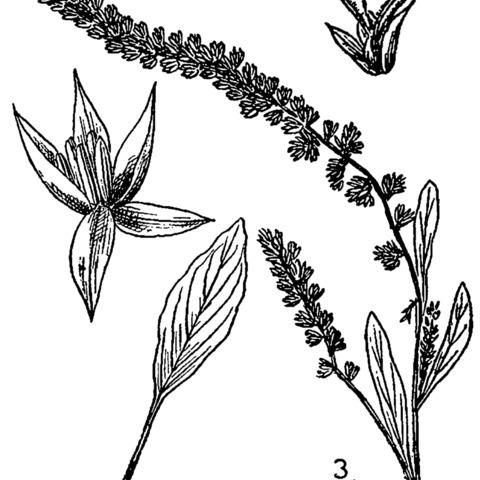Plants glabrous or nearly so. Stems erect, usually branched or occasionally ± simple, 0.4-1.5(-2) m; branches sometimes ascending. Leaves: petiole shorter than or rarely ± equaling blade; blade mostly narrowly ovate, obovate, elliptic, or lanceolate, 1.5-8 × 0.5-3 cm, thin and soft, base cuneate to nearly rounded, margins entire, plane or irregularly undulate, apex subacute to obtuse, with terminal mucro. Inflorescences mostly terminal, spikes to panicles, erect to nodding, rarely with axillary clusters in proximal part of plant. Bracts: of pistillate flowers with short, excurrent midrib, (1.5-)2-2.5 mm, equaling tepals or nearly so, apex acute or acuminate; of staminate flowers with prominent midribs, 2-3.5 mm, shorter than tepals, apex acute. Pistillate flowers: tepals spatulate, 1.5-2.5 mm, apex obtuse, with terminal mucro; style branches ± erect; stigmas 2-3. Staminate flowers: tepals 5, equal or subequal, 3 mm, apex obtuse to subacute; inner tepals with apex indistinctly mucronulate; stamens 5. Utricles light brown to brown, subglobose, 1.5-2 mm, shorter than tepals, walls thin, usually smooth. Seeds dark reddish brown, (0.9-)1-1.2 mm diam., shiny.
More
Dioecious; erect, to 2 m; lvs long-petioled, oblong to lanceolate, 2–8 cm; terminal thyrse 1–4 dm, 1 cm thick, nearly continuous, the lateral ones shorter; bracts 1.5–2.5 mm, mostly shorter than the sep, with heavy, not or scarcely excurrent midvein; male fls with 5 subequal sep, these 2–3 mm, obtuse, apiculate, but the dark midvein not excurrent; female fls with 5 recurved-spatulate sep, the outer 2–2.5 mm, the inner 1.5–2 mm, all emarginate or obtuse, but the outer apiculate; fr 1.5 mm, circumscissile at the middle; style-branches usually 2; seed 1– 1.2 mm, round, dark reddish-brown; 2n=32. Dry, commonly sandy places; w. Mo. to N.D., Mont., and Tex., and intr. in disturbed soil at scattered stations e. to the Atlantic. (A. torreyi, misapplied)

